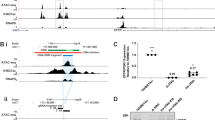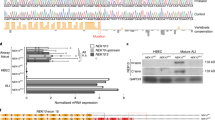Abstract
Successful gene therapy will require that the therapeutic gene be expressed at a sufficient level in the correct cell type(s). To improve the specificity of gene transfer for cystic fibrosis (CF) and other airway diseases, we have begun to develop cell-type specific promoters to target the expression of transgenes to specific airway cell types. Using a FOXJ1 promoter construct previously shown to direct transgene expression specifically to ciliated cells, we have generated transgenic mice expressing human cystic fibrosis transmembrane conductance regulator (CFTR) in the murine tracheal and nasal epithelia. RNA analysis demonstrated levels of CFTR expression is greater than or equal to the level of endogenous mouse CFTR. Immunoprecipitation and western blotting demonstrated the production of human CFTR protein, and immunochemistry confirmed that CFTR was expressed in the apical region of ciliated cells. The transgenic animals were bred to CFTR null mice (Cftrtm1Unc) to determine if expression of CFTR from the FOXJ1 promoter is capable of correcting the airway defects in Cl− secretion and Na+ absorption that accompany CF. Isolated trachea from neonatal CF mice expressing the FOXJ1/CFTR transgene demonstrated a correction of forskolin-stimulated Cl− secretion. However, expression of human CFTR in ciliated cells of the nasal epithelia failed to significantly change the nasal bioelectrics of the CF mice.
This is a preview of subscription content, access via your institution
Access options
Subscribe to this journal
Receive 12 print issues and online access
$259.00 per year
only $21.58 per issue
Buy this article
- Purchase on Springer Link
- Instant access to full article PDF
Prices may be subject to local taxes which are calculated during checkout






Similar content being viewed by others
References
Riordan JR, Rommens JM, Kerem B-S, Alon N, Rozmahel R, Grzelczak Z et al. Identification of the cystic fibrosis gene:cloning and characterization of complementary DNA. Science 1989; 245: 1066–1073.
Rommens JM, Iannuzzi MC, Kerem B-S, Drumm ML, Melmer G, Dean M et al. Identification of the cystic fibrosis gene: chromosome walking and jumping. Science 1989; 245: 1059–1065.
Griesenbach U, Geddes DM, Alton EW . Update on gene therapy for cystic fibrosis. Curr Opin Mol Ther 2003; 5: 489–494.
Montier T, Delepine P, Pichon C, Ferec C, Porteous DJ, Midoux P . Non-viral vectors in cystic fibrosis gene therapy: progress and challenges. Trends Biotechnol 2004; 22: 586–592.
Cotton CU, Stutts MJ, Knowles MR, Gatzy JT, Boucher RC . Abnormal apical cell membrane in cystic fibrosis respiratory epithelium. J Clin Invest 1987; 79: 80–85.
Kreda SM, Mall M, Mengos A, Rochelle L, Yankaskas J, Riordan JR et al. Characterization of wild-type and deltaF508 cystic fibrosis transmembrane regulator in human respiratory epithelia. Mol Biol Cell 2005; 16: 2154–2167.
Puchelle E, Gaillard D, Ploton D, Hinnrasky J, Fuchey C, Boutterin MC et al. Differential localization of the cystic fibrosis transmembrane conductance regulator in normal and cystic fibrosis airway epithelium. Am J Respir Cell Mol Biol 1992; 7: 485–491.
Engelhardt JF, Yankaskas JR, Ernst SA, Yang Y, Marino CR, Boucher RC et al. Submucosal glands are the predominant site of CFTR expression in the human bronchus. Nat Genet 1992; 2: 240–248.
Harris A, McCarthy V . The CFTR gene and regulation of its expression. Pediatr Pulmonol 2005; 40: 1–8.
Yoshimura K, Rosenfeld MA, Nakamura H, Scherer EM, Pavirani A, Lecocq JP et al. Expression of the human cystic fibrosis transmembrane conductance regulator gene in the mouse lung after in vivo intratracheal plasmid-mediated gene transfer. Nucleic Acids Res 1992; 20: 3233–3240.
Virella-Lowell I, Zusman B, Foust K, Loiler S, Conlon T, Song S et al. Enhancing rAAV vector expression in the lung. J Gene Med 2005; 7: 842–850.
Gill DR, Smyth SE, Goddard CA, Pringle IA, Higgins CF, Colledge WH et al. Increased persistence of lung gene expression using plasmids containing the ubiquitin C or elongation factor 1alpha promoter. Gene Therapy 2001; 8: 1539–1546.
Boucher RC . New concepts of the pathogenesis of cystic fibrosis lung disease. Eur Respir J 2004; 23: 146–158.
Koehler DR, Hannam V, Belcastro R, Steer B, Wen Y, Post M et al. Targeting transgene expression for cystic fibrosis gene therapy. Mol Ther 2001; 4: 58–65.
Ostrowski LE, Hutchins JR, Zakel K, O'Neal WK . Targeting expression of a transgene to the airway surface epithelium using a ciliated cell-specific promoter. Mol Ther 2003; 8: 637–645.
Snouwaert JN, Brigman KK, Latour AM, Malouf NN, Boucher RC, Smithies O et al. An animal model for cystic fibrosis made by gene targeting. Science 1992; 257: 1083–1088.
Drumm ML, Pope HA, Cliff WH, Rommens JM, Marvin SA, Tsui LC et al. Correction of the cystic fibrosis defect in vitro by retrovirus-mediated gene transfer. Cell 1990; 62: 1227–1233.
Mall M, Kreda SM, Mengos A, Jensen TJ, Hirtz S, Seydewitz HH et al. The DeltaF508 mutation results in loss of CFTR function and mature protein in native human colon. Gastroenterology 2004; 126: 32–41.
Grubb BR, Paradiso AM, Boucher RC . Anomalies in ion transport in CF mouse tracheal epithelium. Am J Physiol 1994; 267: C293–C300.
MacVinish LJ, Gill DR, Hyde SC, Mofford KA, Evans MJ, Higgins CF et al. Chloride secretion in the trachea of null cystic fibrosis mice: the effects of transfection with pTrial10-CFTR2. J Physiol 1997; 499: 677–687.
Davidson DJ, Rolfe M . Mouse models of cystic fibrosis. Trends Genet 2001; 17: S29–S37.
Grubb BR, Boucher RC . Pathophysiology of gene-targeted mouse models for cystic fibrosis. Physiol Rev 1999; 79: S193–S214.
Rochelle LG, Li DC, Ye H, Lee E, Talbot CR, Boucher RC . Distribution of ion transport mRNAs throughout murine nose and lung. Am J Physiol Lung Cell Mol Physiol 2000; 279: L14–L24.
Shen BQ, Finkbeiner WE, Wine JJ, Mrsny RJ, Widdicombe JH . Calu-3: a human airway epithelial cell line that shows cAMP-dependent Cl− secretion. Am J Physiol 1994; 266: L493–L501.
Mohler PJ, Kreda SM, Boucher RC, Sudol M, Stutts MJ, Milgram SL . Yes-associated protein 65 localizes p62(c-Yes) to the apical compartment of airway epithelia by association with EBP50. J Cell Biol 1999; 147: 879–890.
Murphy DB, Seemann S, Wiese S, Kirschner R, Grzeschik KH, Thies U . The human hepatocyte nuclear factor 3/fork head gene FKHL13: genomic structure and pattern of expression. Genomics 1997; 40: 462–469.
Pickles RJ . The development of paramyxovirus vectors for efficient delivery of CFTR to ciliated airway epithelium. Pediatr Pulmonol 2004; Suppl 27: 137–138.
Schmid A, Bai G, Schmid N, Zaccolo M, Ostrowski LE, Conner GE et al. Real-time analysis of cAMP-mediated regulation of ciliary motility in single primary human airway epithelial cells. J Cell Sci 2006; 119: 4176–4186.
Rawlins EL, Ostrowski LE, Randell SH, Hogan BL . Inaugural article: Lung development and repair: contribution of the ciliated lineage. Proc Natl Acad Sci USA 2007; 104: 410–417.
Dorin JR, Dickinson P, Alton EW, Smith SN, Geddes DM, Stevenson BJ et al. Cystic fibrosis in the mouse by targeted insertional mutagenesis. Nature 1992; 359: 211–215.
Ziady AG, Kelley TJ, Milliken E, Ferkol T, Davis PB . Functional evidence of CFTR gene transfer in nasal epithelium of cystic fibrosis mice in vivo following luminal application of DNA complexes targeted to the serpin–enzyme complex receptor. Mol Ther 2002; 5: 413–419.
Limberis M, Anson DS, Fuller M, Parsons DW . Recovery of airway cystic fibrosis transmembrane conductance regulator function in mice with cystic fibrosis after single-dose lentivirus-mediated gene transfer. Hum Gene Ther 2002; 13: 1961–1970.
Grubb BR, Pickles RJ, Ye H, Yankaskas JR, Vick RN, Engelhardt JF et al. Inefficient gene transfer by adenovirus vector to cystic fibrosis airway epithelia of mice and humans. Nature 1994; 371: 802–806.
Parsons DW, Grubb BR, Johnson LG, Boucher RC . Enhanced in vivo airway gene transfer via transient modification of host barrier properties with a surface-active agent. Hum Gene Ther 1998; 9: 2661–2672.
Yorifuji T, Lemna WK, Ballard CF, Rosenbloom CL, Rozmahel R, Plavsic N et al. Molecular cloning and sequence analysis of the murine cDNA for the cystic fibrosis transmembrane conductance regulator. Genomics 1991; 10: 547–550.
Lansdell KA, Delaney SJ, Lunn DP, Thomson SA, Sheppard DN, Wainwright BJ . Comparison of the gating behaviour of human and murine cystic fibrosis transmembrane conductance regulator Cl− channels expressed in mammalian cells. J Physiol 1998; 508 (Part 2): 379–392.
Yan W, Samaha FF, Ramkumar M, Kleyman TR, Rubenstein RC . Cystic fibrosis transmembrane conductance regulator differentially regulates human and mouse epithelial sodium channels in Xenopus oocytes. J Biol Chem 2004; 279: 23183–23192.
Rozmahel R, Gyomorey K, Plyte S, Nguyen V, Wilschanski M, Durie P et al. Incomplete rescue of cystic fibrosis transmembrane conductance regulator deficient mice by the human CFTR cDNA. Hum Mol Genet 1997; 6: 1153–1162.
Zhou L, Dey CR, Wert SE, DuVall MD, Frizzell RA, Whitsett JA . Correction of lethal intestinal defect in a mouse model of cystic fibrosis by human CFTR. Science 1994; 266: 1705–1708.
French PJ, van Doorninck JH, Peters RH, Verbeek E, Ameen NA, Marino CR et al. A delta F508 mutation in mouse cystic fibrosis transmembrane conductance regulator results in a temperature-sensitive processing defect in vivo. J Clin Invest 1996; 98: 1304–1312.
Becq F, Mettey Y, Gray MA, Galietta LJ, Dormer RL, Merten M et al. Development of substituted Benzo[c]quinolizinium compounds as novel activators of the cystic fibrosis chloride channel. J Biol Chem 1999; 274: 27415–27425.
Grubb BR, Rogers TD, Kulaga HM, Burns KA, Wonsetler RL, Reed RR et al. Olfactory epithelia exhibit progressive functional and morphological defects in CF mice. Am J Physiol Cell Physiol 2007 (in press).
Parsons DW, Hopkins PJ, Bourne AJ, Boucher RC, Martin AJ . Airway gene transfer in mouse nasal-airways: importance of identification of epithelial type for assessment of gene transfer. Gene Therapy 2000; 7: 1810–1815.
Jiang C, Akita GY, Colledge WH, Ratcliff RA, Evans MJ, Hehir KM et al. Increased contact time improves adenovirus-mediated CFTR gene transfer to nasal epithelium of CF mice. Hum Gene Ther 1997; 8: 671–680.
Arimoto Y, Nagata H, Isegawa N, Kumahara K, Isoyama K, Konno A et al. In vivo expression of adenovirus-mediated lacZ gene in murine nasal mucosa. Acta Otolaryngol 2002; 122: 627–633.
Grubb BR . Bioelectric measurement of CFTR function in mice. Methods Mol Med 2002; 70: 525–535.
Acknowledgements
We thank Dr JR Riordan for the monoclonal antibodies against CFTR, K Busalacchi for technical support and Dr RC Boucher for helpful suggestions and support. We also acknowledge the excellent services and support of K Burns and the members of the Cystic Fibrosis Center Histology Core, Dr M Chua and W Salmon of the Michael Hooker Microscopy Facility, and Dr B Koller's laboratory for providing CF mice. This work was funded in part by NIH (HL70199 (LEO), DK065988 (RCB), HL34322 (RCB), and HL060280 (RCB)) and the Cystic Fibrosis Foundation (Ostrow04GO (LEO) and R026-CR02 (RCB)).
Author information
Authors and Affiliations
Corresponding author
Additional information
Supplementary Information accompanies the paper on Gene Therapy website (http://www.nature.com/gt).
Rights and permissions
About this article
Cite this article
Ostrowski, L., Yin, W., Diggs, P. et al. Expression of CFTR from a ciliated cell-specific promoter is ineffective at correcting nasal potential difference in CF mice. Gene Ther 14, 1492–1501 (2007). https://doi.org/10.1038/sj.gt.3302994
Received:
Revised:
Accepted:
Published:
Issue Date:
DOI: https://doi.org/10.1038/sj.gt.3302994
Keywords
This article is cited by
-
Tissue and cell-type-specific transduction using rAAV vectors in lung diseases
Journal of Molecular Medicine (2021)
-
A revised airway epithelial hierarchy includes CFTR-expressing ionocytes
Nature (2018)
-
Clinical Review: Gene-based therapies for ALI/ARDS: where are we now?
Critical Care (2011)
-
Toward Gene Therapy for Cystic Fibrosis Using a Lentivirus Pseudotyped With Sendai Virus Envelopes
Molecular Therapy (2010)
-
Influence of the cystic fibrosis transmembrane conductance regulator on expression of lipid metabolism-related genes in dendritic cells
Respiratory Research (2009)



